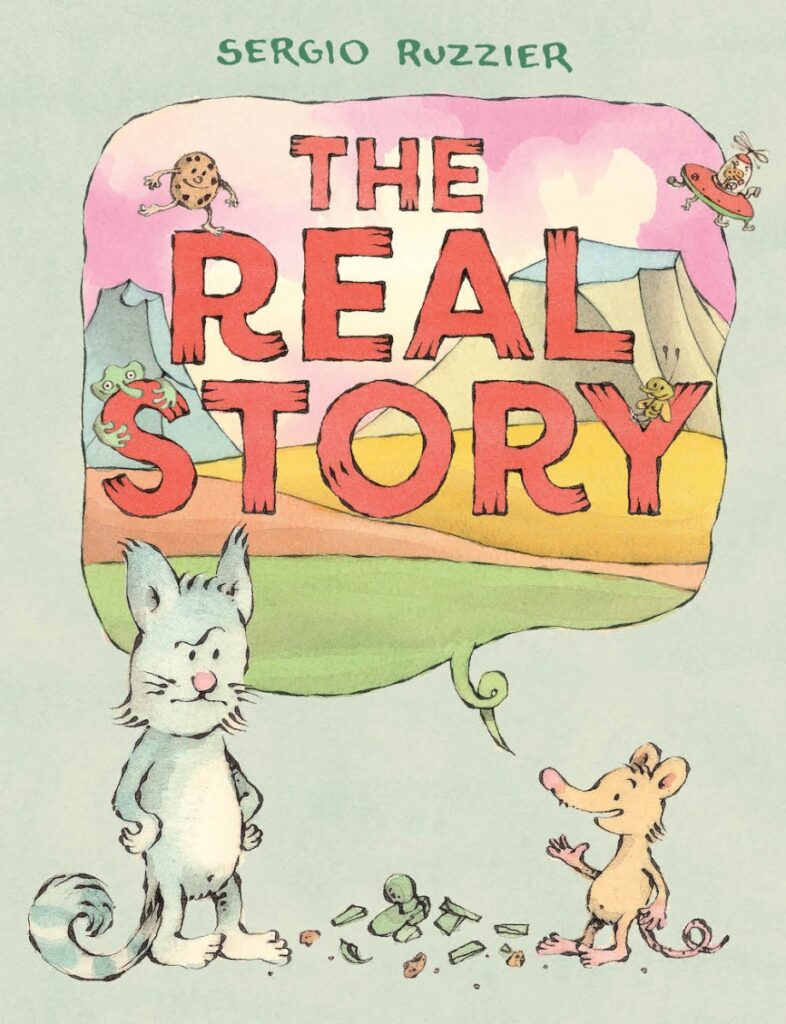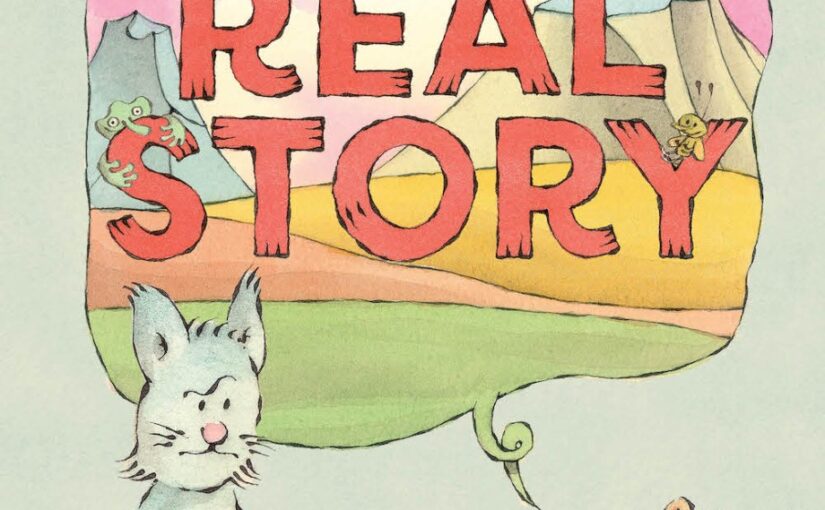You can tell the children’s authors or illustrators that can inhabit the soul of their books. It’s those books or characters that ooze effortless charm. They can jump into the psyche of their young audience and create a book they, themselves, would want to read if they could travel back in time. They are the books that all but read themselves to young audiences. Sergio Ruzzier creates children’s illustrated books that saddle up to emerging readers in the most charming of ways. Initially, his illustrations might seem like a rip-off because you’ll feel as if you’ve seen them before. However, such is the nature of a timeless creation that’s so utterly comfortable with its audience. The Real Story is one of those examples in that its characters; even from looking at them on the book’s cover feel like they’re having a conversation that a three through eight-year-old might be having.

There’s a broken cookie jar in between the cat and the mouse. The cat looks very surly and the mouse seems jovial and ready to become anyone’s next best friend. The mouse has the book’s title in a speech bubble with a long-nosed green monster, a dancing chocolate chip cookie, a bug, and an alien flying around in its UFO. The background in the speech bubble has magical colors that would be at home on a different planet or a very unrealistic Instagram filter.
The classic comic books are known for their covers. The better the cover is, the more issues that they’ll sell and the higher pedigree the character will become, or already is. The Real Story has a great cover. It makes people curious to see what the mouse is babbling on about, why the cat is angry, and what world the smaller creatures in the book’s letters inhabit.
The MacGuffin in The Real Story is what happened to the aforementioned broken cookie jar. Cat comes into the living room to see that the cookie jar is lying broken on the floor. All of the cookies that were in it are gone and the mouse is blindly stating the obvious. “It looks like a broken cookie jar to me.”, the cat naively says when asked by the cat what happened.
The mouse says that the cookies were tired of being cooped up inside the closed jar, and started jumping up and down. Once they had escaped the confounds of their pastry prison they started to run through the country that has the aforementioned multi-colored landscape that exists on some perfect planet.
The cat glibly says that the mouse’s explanation isn’t possible because cookies can’t run, but follows it up by demanding that the mouse tell him the real story. The mouse continues to spin three more short yarns about what impossible thing happened for the cookies to have disappeared. After four fantastical stories the cat becomes exasperated and screams at the mouse to please tell him what happened.
The mouse agrees and simply tells the cat that he ate all of the cookies and that the jar fell off of the table. They both agree that what happened is a boring story. However, the cat enjoyed the mouse’s stories so much that he giddily asked if he could hear another one. As the two start to walk on the Instagram filter, a different planet landscape the mouse says that he’d gladly tell a story, but asks if he can have a cookie beforehand.
The pacing and the humor is what will strike elementary-aged children first about The Real Story. Those ages won’t be able to articulate it, but that’s what they’ll think. The pages offer the conflict, like when the cat discovers the broken jar, or the humor of the now free-range cookies running from Shawshank, two pages so that they can breathe or find their way. It’s a very subtle thing, but had the initial conflict played out on one page it would’ve felt cheap and robbed audiences of the chance to get to know the two main characters.
Once the mouse starts telling tales it’s the silliness that will drive the book’s entertainment. As an older reader, it reminded us of a more kid-friendly, Snappy Answers to Stupid Questions by Al Jaffee. That classic Mad Magazine bit is the sort of middle-school gold that no longer exists. The Real Story takes that same madcap humor and intelligence and firmly places it in a package that’s perfect for ages three through seven. Those ages will lose themselves in the illustrations, laugh out loud at the absurdity of the stories, and spend time with the book without any supervision.
The Real Story will become one of their favorite good-night books. It’s the kind of book that will yield such strong memories that it’ll rarely be seen in used bookstores. It will have a spot in the forever bookshelf in the corner of your kid’s room until you move those books into a box that you’ll save for their future, when they read them to their kids.
The Real Story is by Sergio Ruzzier and is available on Abrams Appleseed, an imprint of Abrams Books.
There are affiliate links in this post.





 Facebook
Facebook Twitter
Twitter Flickr
Flickr GooglePlus
GooglePlus Youtube
Youtube